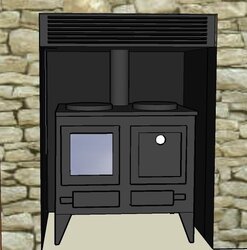Hi, I've read the various advice here on using a wood stove as backup heat in a solar hydronic system, and plan to press on regardless. Apparently wood stove boilers in Europe routinely run radiators, baseboards and slabs, but I've given up on finding one in this side of Atlantic. I need your help with fabricating air and water heat exchangers that will capture up about two thirds of a conventional stove's heat.
The stove will be centrally located in a 1,000 sf room. I want to pull off enough heat in an air heat exchanger to keep a 600 SF second floor at roughly equivalent temperatures. I also want a backboiler that will move heat to the slab on the main floor via thermosiphon and indirect tank. The idea is meet a maximum 25k btu/hr heat loss on days when the sun doesn't shine and bank enough heat in concrete floors/walls to carry the house through much of the night. I would be perfectly content with a 10-degree daily swing.
I have a blank slate because the house doesn't exist yet. I have attached (I hope) a graphic that seems to me to be a reasonable approach. I'd tuck the stove in what would appear to have been a fireplace. I'd complete surround it with an insert of steel plate to capture radiant heat in four of six directions. I'd route the smoke through and around an air heat exchanger at the top of the insert a la an oven or masonry stove. An air handler directly above would pull air through this exchanger and circulate it on the second floor.
Plenty of possibilities for water as well: a radiator tucked behind the stove; a coil inside the stove, or on the back; OWB type exchangers built into the air exchanger. All of the above.
Yes, I understand that I can ruin the stove's efficiency by being overly greedy. I'd want most of the exchanging done outside the fire box. The chimney will have R10 insulation in a straight run from about 6-8 feet to a cap at about 20 feet.
The graphic shows a British made Esse Ironheart, which claims 26k btu/hr, with 15k btu output to water. It's sold here because it is exempt from EPA certification as a cooker. Alas, I figure I need 40k to 50k btu/hour to produce enough heat in a hot, efficient burn of six to eight hours. Stove recommendations also welcome. I'd need an outside air supply, and an automatic shutdown feature would be nice. Other than that I am not fussy at all.
The stove will be centrally located in a 1,000 sf room. I want to pull off enough heat in an air heat exchanger to keep a 600 SF second floor at roughly equivalent temperatures. I also want a backboiler that will move heat to the slab on the main floor via thermosiphon and indirect tank. The idea is meet a maximum 25k btu/hr heat loss on days when the sun doesn't shine and bank enough heat in concrete floors/walls to carry the house through much of the night. I would be perfectly content with a 10-degree daily swing.
I have a blank slate because the house doesn't exist yet. I have attached (I hope) a graphic that seems to me to be a reasonable approach. I'd tuck the stove in what would appear to have been a fireplace. I'd complete surround it with an insert of steel plate to capture radiant heat in four of six directions. I'd route the smoke through and around an air heat exchanger at the top of the insert a la an oven or masonry stove. An air handler directly above would pull air through this exchanger and circulate it on the second floor.
Plenty of possibilities for water as well: a radiator tucked behind the stove; a coil inside the stove, or on the back; OWB type exchangers built into the air exchanger. All of the above.
Yes, I understand that I can ruin the stove's efficiency by being overly greedy. I'd want most of the exchanging done outside the fire box. The chimney will have R10 insulation in a straight run from about 6-8 feet to a cap at about 20 feet.
The graphic shows a British made Esse Ironheart, which claims 26k btu/hr, with 15k btu output to water. It's sold here because it is exempt from EPA certification as a cooker. Alas, I figure I need 40k to 50k btu/hour to produce enough heat in a hot, efficient burn of six to eight hours. Stove recommendations also welcome. I'd need an outside air supply, and an automatic shutdown feature would be nice. Other than that I am not fussy at all.


